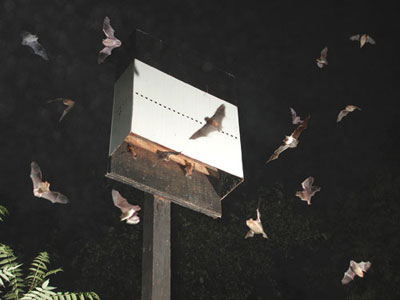 Bats are very clean animals, and groom themselves almost constantly (when not eating or sleeping) to keep their fur soft and clean, like tiny cats.
Bats are very clean animals, and groom themselves almost constantly (when not eating or sleeping) to keep their fur soft and clean, like tiny cats.
The world's smallest mammal is the bumblebee bat of Thailand, weighing less than a penny.
Giant flying foxes that live in Indonesia have wingspans of nearly six feet.
The common little brown bat of North America is the world's longest lived mammal for its size, with life-spans sometimes exceeding 32 years.
Mexican free-tailed bats sometimes fly up to two miles high to feed or to catch tail-winds that carry them over long distances at speeds of more than 60 miles per hour.
The pallid bat of western North America is immune to the stings of scorpions and even the seven-inch centipedes upon which it feeds.
Fishing bats have echolocation so sophisticated that they can detect a minnow's fin as fine as a human hair, protruding only two millimeters above a pond's surface.
African heart-nosed bats can hear the footsteps of a beetle walking on sand from a distance of more than six feet.
Red bats that live in tree foliage throughout most of North America can withstand body temperatures as low as 23 degrees F. during winter hibernation.
Tiny woolly bats in West Africa live in the large webs of colonial spiders.
The Honduran white bat is snow white with a yellow nose and ears. It cuts large leaves to make "tents" that protect its small colonies from jungle rains.
Disk-winged bats of Latin America have adhesive disks on both wings and feet that enable them to live in unfurling banana leaves (or even walk up a window pane!).
Frog-eating bats identify edible from poisonous frogs by listening to the mating calls of male frogs. Frogs counter by hiding and using short, difficult to locate calls.
Vampire bats adopt orphans and have been known to risk their lives to share food with less fortunate roost-mates.
Male epauletted bats have pouches in their shoulders which contain large, showy patches of white fur that they flash during courtship to attract mates.
Mother Mexican free-tailed bats find and nurse their own young, even in huge colonies where many millions of babies cluster at up to 500 per square foot.
Nearly 1,000 kinds of bats account for almost a quarter of all mammal species, and most are highly beneficial.
Worldwide, bats are the most important natural enemies of night-flying insects.
A single little brown bat can catch 600 mosquitoes in just one hour.
A colony of 150 big brown bats can protect local farmers from up to 18 million or more rootworms each summer.
The 20 million Mexican free-tails from Bracken Cave, Texas eat 250 tons of insects nightly.
Tropical bats are key elements in rain forest ecosystems which rely on them to pollinate flowers and disperse seeds for countless trees and shrubs.
In the wild, important agricultural plants, from bananas, breadfruit and mangoes to cashews, dates, and figs rely on bats for pollination and seed dispersal.
Tequila is produced from agave plants whose seed production drops to 1/3,000th of normal without bat pollinators.
Desert ecosystems rely on nectar-feeding bats as primary pollinators of giant cacti, including the famous organ pipe and saguaro of Arizona.
Bat droppings in caves support whole ecosystems of unique organisms, including bacteria useful in detoxifying wastes, improving detergents, and producing gasohol and antibiotics.
The pallid bat of western North America is totally immune to the stings of the scorpions and centipedes upon which it feeds.
An anticoagulant from vampire bat saliva may soon be used to treat human heart patients.
 Contrary to popular misconception, bats are not blind, do not become entangled in human hair, and seldom transmit disease to other animals or humans.
Contrary to popular misconception, bats are not blind, do not become entangled in human hair, and seldom transmit disease to other animals or humans.
All mammals can contract rabies; however, even the less than a half of one percent of bats that do, normally bite only in self-defense and pose little threat to people who do not handle them.
Bats are exceptionally vulnerable to extinction, in part because they are the slowest reproducing mammals on earth for their size, most producing only one young annually.
More than 50% of American bat species are in severe decline or already listed as endangered. Losses are occurring at alarming rates worldwide. Loss of bats increases demand for chemical pesticides, can jeopardize whole ecosystems of other animal and plant species, and can harm human economies.
Bats are more closely related to humans and other primates than they are to rodents. Several studies indicate that the Old World fruit bats and flying foxes may actually be descended from early primates such as lemurs.
Providing bat houses can help build the populations of many valuable bat species that eat many crop-damaging insects, such as cucumber and June beetles, stink bugs, leafhoppers and corn worm moths. Bat houses furnish places for bats to roost, hibernate and raise young, in addition to the dwindling number of natural sites available to them.